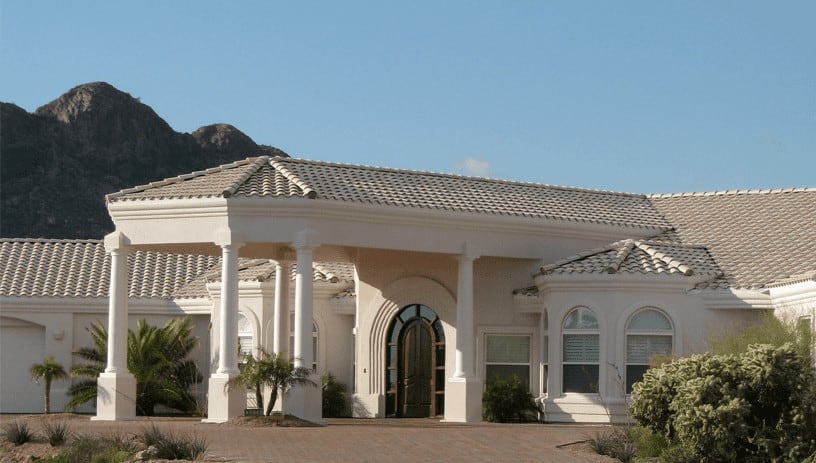When it comes to designing the exterior of your home, you may be wondering what the difference is between a portico and a porte-cochere. Both features can add elegance and sophistication to your house, but they serve different purposes.
A portico is a roofed porch that typically extends across the front of a building, while a porte-cochere is a covered driveway that provides shelter for vehicles. If you’re unsure which feature would be best for your home, keep reading to learn more about the benefits of each one.

Difference Between Portico and Porte Cochere
A portico is a roofed porch that typically extends across the front of a building, while a porte-cochere is a covered driveway that provides shelter for vehicles.
A porte-cochère (English and French: “coach gate”; also known as a “carriage porch”) is a covered structure at a building’s principal or secondary entry that allows occupants to depart a horse and carriage (or motor vehicle) while being shielded from the elements.
A portico is a roofed porch that typically extends across the front of a building. It can be supported by columns or posts and is often enclosed. A porte-cochere, on the other hand, is a covered driveway that provides shelter for vehicles.
It is typically located at the entrance of a property, and cars can drive right up to it. Both porticos and porte-cocheres can add a touch of elegance to a building.
What Is the Difference Between a Carport and A Porte Cochere?
A carport is a covered parking structure for one or two cars. It can be either attached to the side of your house or freestanding. A porte cochere, on the other hand, is a covered entryway that extends from the side of your house to provide shelter for passengers as they get in and out of vehicles.
While a carport only covers the parking area, a porte-cochere also covers the walkway leading to your front door.
So, what is the difference between a carport and a porte-cochere? The main difference is that a porte-cochere provides shelter not just for your vehicles but also for your guests as they make their way to your front door. A carport, on the other hand, is primarily designed for covered parking.
Porte-cocheres are usually found in larger homes or estates since they require more space than a carport. They are also more formal in style and often match the architecture of the house. Carports, on the other hand, are more casual and can be made from a variety of materials, including metal, wood, or plastic.

What Is a Drive Through Portico Called?
A driveway that passes through a structure or screen wall to allow vehicles to enter an interior courtyard from the street.
A portico is a structure that is attached to the front of a building. It typically has columns or pillars supporting a roof. A portico can be used as an entranceway to a building, or it can simply be decorative.
A drive-through portico is one that allows vehicles to pass through it, typically into an interior courtyard. Drive through porticos are also sometimes called arcade drives.
What Is the Cover Over a Driveway Called?
It is called a Porte-cochere.
A porte-cochere (/ˈpɔːrtəkoʊʃər/ or /ˈpɔːrtkoʊʃər/) is a covered porch-like structure at the main entrance to a building. Porte-cocheres protect visitors and occupants of the building from inclement weather. They also provide a convenient covered area for unloading and loading passengers and baggage.
Porte-cocheres are commonly found on large estates, hotels, and public buildings such as schools and government offices. In France, this type of structure is often called a perron.
The term porte-cochere is French for “carriage entrance”. It comes from the verb cocher, meaning “to go” or “to drive”, and the noun porte, meaning “door” or “gate”. Thus, a porte-cochere is literally a “door that goes”.
In France, the term perron typically refers to the stone stairway leading up to the main entrance of a château or manor house. However, some porte-cocheres in France are also called perrons.
The term portico is sometimes used synonymously with porte-cochere, but a portico is more properly defined as a covered porch supported by columns. A porte-cochere, on the other hand, is typically a freestanding structure.
What Is a Portico on A House?
A portico on a house is an open, covered area at the entrance to the home. It typically has columns supporting a roof and may be used as a porch or stoop. A portico can also be added to the front of a garage. Porticos are often found in older homes but can be added to any style of the house.
Conclusion
A portico is a roofed, open-air walkway that spans the front of a building. A porte-cochere (French for “carriage porch”) is a type of portico that shelters the entrance to a building.
They are often used in hotels and other places where guests may be arriving by car. The main difference between a portico and a porte-cochere is that a porte-cochere has at least one wall, while a portico does not.

![What Gravel To Use For Patio Base [Best Options]](https://www.cleverpatio.com/wp-content/uploads/2021/11/What-Gravel-To-Use-For-Patio-Base-270x180.jpg)


Leave a Reply